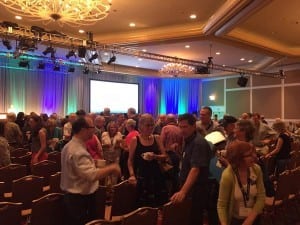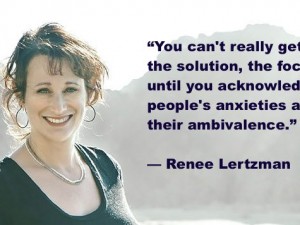
The co-organizers of the meeting sharing four sentences about their work with Pope Francis, with CCL’s Danny Richter taking a picture in the background.
Reflecting on the legacy of Laudato Si
By Danny Richter
After sharing a joke over lunch, Paul and I clinked glasses. I am, rather improbably, referring to Paul Crutzen, the Nobel Laureate in Chemistry who coined the term “Anthropocene” to refer to the geologic period of time in which humans have had a substantial impact on our environment. Even more improbably, we were sitting next to each other inside Vatican City, two of 86 invited participants in the first ever joint meeting between the Pontifical Academy of Sciences and the Pontifical Academy of Social Sciences. Though none of us knew it then, the contents of these proceedings, stretched over five days, would go on to form the substance of “Laudato Si,” Pope Francis’ encyclical on the environment published in 2015. With the recent passing of Pope Francis, it seemed appropriate to reflect on my experience at that meeting in the Vatican, and the legacy that Laudato Si has had since.
When I say “improbable,” I’m really referring to my own presence there. It was the spring of 2014, and I had graduated with my Ph.D. in Oceanography the year before. I was the Legislative and Science Director for Citizens’ Climate Lobby, a position I’d started just over a year before. At the time, CCL had about 3,000 members, and our largest D.C. conference to date had attracted perhaps 400 people.
I managed an invitation as an “observer” to this meeting because I asked one of my grad school professors, Dr. Ram Ramanathan, if I could come. It turned out that he was one of the organizers of the conference. When I asked, I had been envisioning the meeting would be something like the rather large scientific conferences I had attended in the past, where individuals would give presentations on their work as part of a themed session, and there would be time to take questions and mingle, and then everyone moved on to the next talk. After the conference, perhaps the proceedings would be published, but that would be about it.
Instead, only 86 people were invited to this conference — 43 speakers, 28 observers, and 15 members of the Pontifical Academies. The list was quite distinguished, including four Nobel laureates, assuming you don’t count all the IPCC authors who shared a portion of the 2007 Nobel Peace Prize. Nothing in my time in academia or in D.C. would have distinguished me sufficiently to attend on my merits alone.
But there I was. As I mentioned, none of us knew that the series of 20-minute talks we listened to and the discussions that followed during 11-hour days would eventually become Laudato Si. As I reviewed the blogs I wrote for CCL at the time, I was struck by the uncertainty of where this was all heading, as well as my own skepticism that any lasting or meaningful result would come of this. Yet, the first time I read Laudato Si, it was immediately obvious that those talks had greatly informed the writing of the document. For many of the talks, it was 1 to 1 — what was said by the invited speakers ended up directly in the encyclical.
To understand its impact, it’s essential to consider the context in which this encyclical was released. It was published in May of 2015. Barack Obama was president, John Boehner was Speaker of the House, and America was already six years removed from the last (unsuccessful) major efforts to arrive at comprehensive climate legislation. On Sept. 17 of that year, Rep. Chris Gibson of New York and 10 of his Republican colleagues submitted what we informally called “the Gibson Resolution” that did indeed say that climate change is real, humans have had an impact, and Congress should act to address this. CCL was a heavy supporter of this effort, and it felt like a big deal.
A week later, Pope Francis addressed the U.S. Congress at the invitation of Speaker Boehner, highlighting messages of stewardship from his groundbreaking encyclical “Laudato Si” earlier that year. CCL took an active part in handing out a copy of Laudato Si to every congressional office ahead of that talk, delivering 540 copies to the Hill. Speaker Boehner wore a green tie, and the next day he announced he was stepping down as Speaker of the House. In 2015, bipartisan action on climate was actually more difficult to believe in than it is now. The contrast is especially sharp when contrasting the modesty of the Gibson Resolution with the Conservative Climate Caucus standing at 69 members, the climate provisions in the Infrastructure Investment and Jobs Act (IIJA) having passed with robust margins in 2021, and 21 House Republicans signing a letter to their own leadership calling to protect the clean energy provisions of the Inflation Reduction Act.
The Paris Climate Agreement would be signed later that year. It has become the bedrock agreement for globally coordinated efforts to address climate change. The UN Millennium Development goals would be renamed “Sustainable Development Goals” at the end of 2015, a fact that was previewed for us in the Vatican in 2014. The caliber of people in the room during these discussions was such that it’s not a stretch at all to imagine such a renaming was entangled with the writing and publication of the encyclical. Achim Steiner, the UNEP Executive Director and under-secretary-general of UN, was a speaker in attendance.
Laudato Si is rather unclear on the topic of a carbon price, but my reading of it is that a carbon tax can pass muster, but a cap-and-trade system is suspect, based on the brief skepticism expressed towards carbon credits. The U.S. Conference of Catholic Bishops issued a statement of support for the Energy Innovation and Carbon Dividend Act in 2019, which remains on their website. While the U.S. still doesn’t have a carbon price, every other developed economy in the world does have one. The International Maritime Organization just last week voted to place a price on global shipping. Especially since the EU CBAM went into place, adoption of carbon pricing (and border adjustments) around the world is accelerating.
As you might expect, Laudato Si places a strong emphasis on the burden climate change, and the underlying processes driving it, places on the poor. President Biden’s presidency and legislative record are marked by his commitment to environmental justice, most notably the Justice 40 principle that manifested in the way he structured his administration and in the Inflation Reduction Act. Of course, President Biden was only the second Catholic president in U.S. history. Yet, the language of the encyclical and the language of the environmental justice movement in the U.S. strike me as oddly orthogonal. There is less overlap than I’d expect.
Within the Church, progress feels like a slow burn. Curricula have been developed and outreach has been pursued by Catholic organizations such as the Catholic Climate Covenant, whose former Executive Director, Dan Misleh, was a fellow observer with me at the Vatican meeting. However, these have taken a very long time to catch on, and implementation in the U.S. has been patchy. Very anecdotally, as an American Catholic who is in the pews most Sundays, I’ve probably heard a priest mention Laudato Si in a sermon fewer times in the last 10 years than there have been years setting a new temperature record. Last year was the first year to exceed 1.5 degrees C.
What does this all amount to? Within the Church, Laudato Si continues to be a living document that, at least to me, seems to be exerting more influence over time. Globally, Laudato Si was perhaps wind in the sails of the global consciousness ahead of the Paris Climate Agreement, which continues to be a foundational accord to which all subsequent meetings refer back to in global climate negotiations. The commitments it has inspired fall short of its own ambition, but it does continue to inspire ambition. In the United States, Laudato Si perhaps played a significant role in shifting the zeitgeist away from climate denial, and toward hope. Though its major theme is the impact of poor stewardship on the poor, that has not broken through in the United States, at least not in a way that rhymes with the language of the encyclical.
These, at least, are the reflections of someone who was there at the beginning. My friend Paul is no longer with us, having passed in 2021. Walter Munk, the researcher who figured out how the tides worked in time to advise the Allies ahead of the D-Day invasion was also at our table for that lunch has also passed. So too, now, has Pope Francis.
He met us on the last day of the Conference. We waited for 30 minutes for him to arrive, in the Roman sun a stone’s throw from St. Peter’s Basilica. I reflected at the time about how interesting it was to observe what people who had steered the world’s consciousness do when they have 30 minutes to kill. Turns out, they do what other people do. They make idle chit chat, crack jokes, complain, and turn tourist. Underlining the uncertainty of what these five days of effort would yield, the organizers of the conference got to speak to Pope Francis, and they were allowed four sentences. Though such limited interaction fueled my doubts at the time, in light of what has happened since, it’s pretty clear that Pope Francis was always on our side. He wanted that conference to be a success, and he wanted Laudato Si to be a meaningful document that pushed the world toward action. I cannot speak to whether its impact had the effect he hoped it would, but to me at least, it seems as if it has played a positive role in moving the world away from denial, toward action, and toward considering the direct connection between people and the environment, and especially the poor.
Connect with CCL’s Catholic Action Team on CCL Community.





